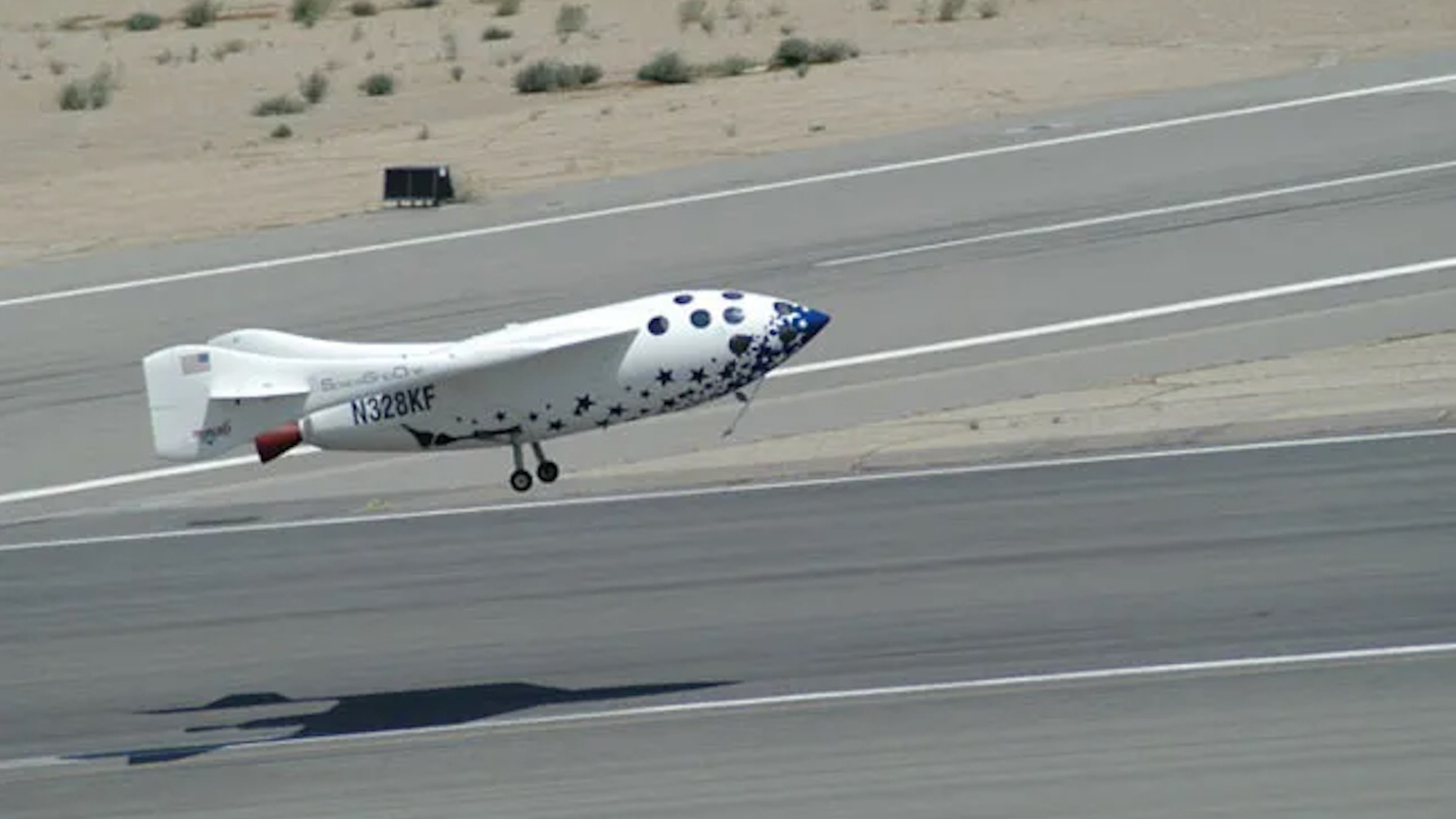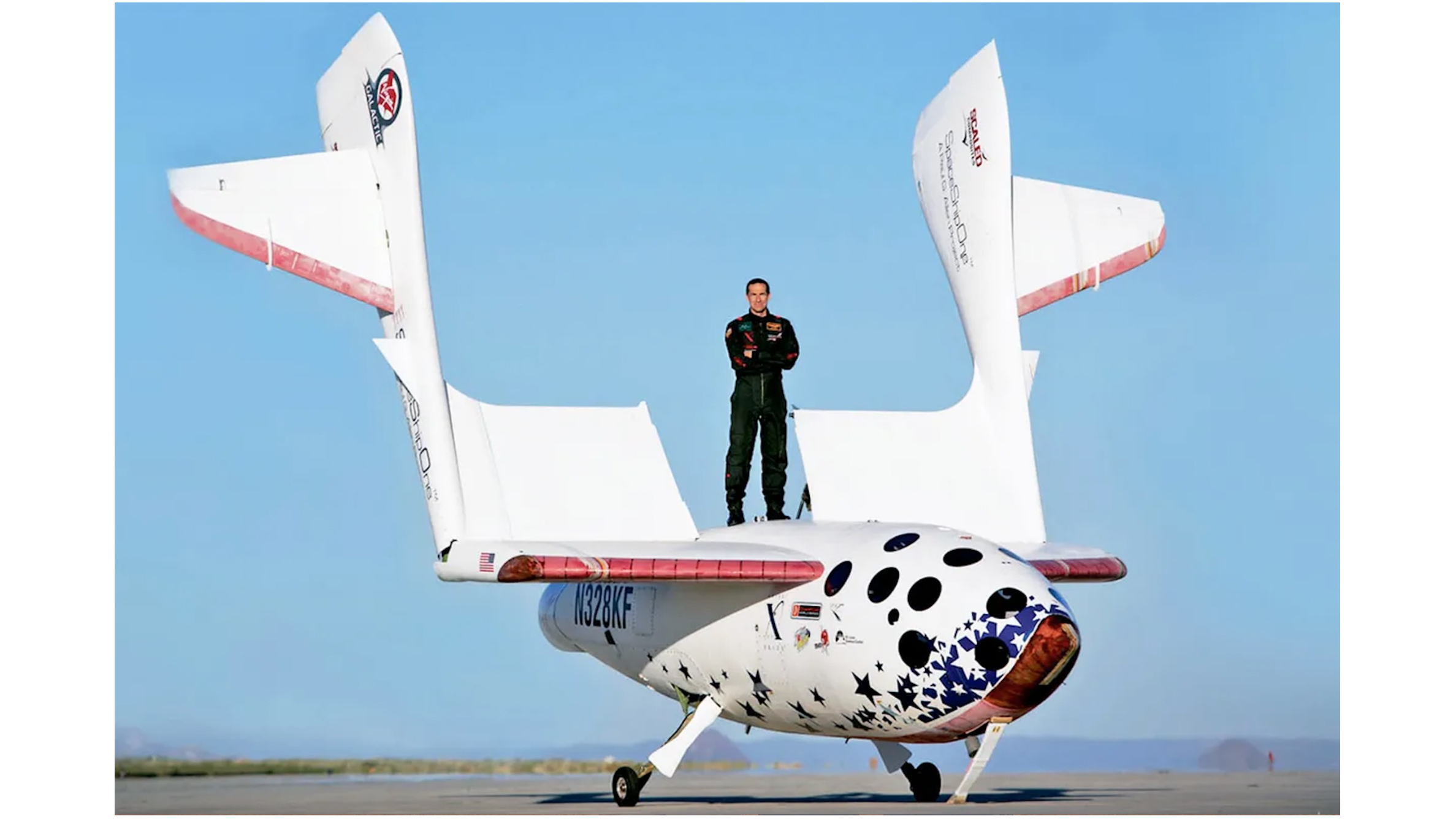
It was a one-of-a-kind moment for a throng of well-wishers, including this reporter, all in nose-up, sky-squinting position at California's Mojave Airport on June 21, 2004.
Let loose from its White Knight mothership, the rocket engine propelling the experimental suborbital SpaceShipOne vehicle roared to life, skillfully controlled by test pilot Mike Melvill.
That pioneering first spaceflight lasted 24 minutes, gliding back to Mojave and sliding straight and true into the history books.
Now, two decades later, Burt Rutan, chief designer of the craft at the company Scaled Composites, reflects on that epic day in an exclusive interview with Space.com.
Start spreading the news
Following the flight, Rutan saw a sign being held in the crowd. It read: "SpaceShipOne, Government Zero."
"I thought, 'That's cool. Let me see if I could display it with the spaceship,'" Rutan said. "It wasn't ours. I found out later it was put together by libertarians."
Those words speak volumes. They also underscore a truism that spread its wings that memorable day.
"We were covert for two years of a three-and-a-half-year program. Nobody knew what we were up to," Rutan said. "We not only didn't have government help or government equipment; the government had no idea that we were doing a manned space program," he added.
SpaceShipOne — and the intentions of Rutan and his tiny team of like-minded visionaries — were publicly revealed in April 2003, with the rollout of the vehicle. "It was essentially ready to fly," Rutan said, "and we let the world know that we are actually going to try and send our test pilots to space."
Related: Facts about SpaceShipOne, the 1st private spacecraft
Gulp factor
On that big reveal day, the White Knight carrier plane performed an in-flight aerobatic display, adding to the ambience and sky-high excitement of what was to come, taking a private vehicle where none had gone before.
"In general, our program was very much like the proof-of-concept research airplanes that we had done before," said Rutan. But, admittedly, there was a sizable gulp factor when SpaceShipOne first flew.
Before the maiden spaceflight, Rutan remembered an aerodynamics expert eyeing SpaceShipOne and its novel hinged "feathering" system. That unique feature had the rear half of the wing and its twin tail booms fold upward for atmospheric reentry, a position designed to increase drag, but keep the vehicle stable on descent.
"That expert told me it will spin like a top; it wouldn't be controllable if it's in feather," Rutan said. "You know, I didn't have a good answer for him."
Rutan said he was riding on wispy information.
"I had no wind tunnel data in the feathered configuration. I had limited computational fluid dynamics data … no analysis of the dynamics. I couldn't tell whether or not he was right."

Concern resolved
When SpaceShipOne was dropped from the White Knight carrier plane at 40,000 feet (12,000 meters), pilot Mike Melvill didn't say a thing, according to Rutan.
"That will get your ass puckered up if nothing else will," Rutan said. "And I'm thinking, 'For God's sake, tell us how it flies.' And I'll never forget when he said, 'It flies like a dream.' Right then and there one of the biggest concerns that I had was resolved."
SpaceShipOne sped from transonic to supersonic velocity, running its rocket motor for 15 seconds, and ascending to just above 62 miles (100 kilometers) over Earth. It therefore cleared the Kármán line, a widely recognized definition of the boundary of outer space.
"I figured if we had bad flying qualities we are accelerating so fast," Rutan said, "you are going to quickly poke right through it."
When the rocket engine shut off, SpaceShipOne slipped into low speed and the feather system was engaged. The vehicle was successfully maneuvered down to tarmac heaven.
Above the fold
"I did recognize that it was historic, to achieve a non-government manned spaceflight," Rutan said. The flight achievement got "above the fold" newspaper attention around the world.
"It was the number two story for all of 2004. If they hadn't pulled Saddam Hussein out of his spider hole that year," Rutan said, "this would have been the number one story!"
Later that year, SpaceShipOne made two back-to-back suborbital flights well above 100 kilometers in altitude, solo piloted first by Melvill and then Brian Binnie, to snag the $10 million Ansari X Prize purse.
For Rutan, the voyage of SpaceShipOne that day was a huge milestone. "It should get a party every 10 years. And it certainly should get a big party on the 50th and the 100th anniversary."
Aspirational inspiration
"I'm guessing only the true space diehards are cognizant that the first SpaceShipOne suborbital spaceflight, piloted by Mike Melvill, occurred 20 years ago this week," said Alan Ladwig, author of "See You In Orbit? Our Dream Of Spaceflight" (To Orbit Productions, 2019). "It was an important milestone for space tourism."
As the first time a privately built, privately funded spaceship made it to the final frontier, Melvill's critical test flight did attract media and public attention at the time, as Rutan noted. "The event was heralded as a new era when 'ordinary' people, private citizens, would have the opportunity to fly to experience weightlessness," Ladwig said.
When the X-Prize was announced in 1996, later to be renamed the Ansari X Prize, Ladwig recalled that it was predicted that a winner would be crowned in three to five years, with commercial tickets available one or two years after that.
"Like so many space achievements, these predictions proved to be aspirational," Ladwig said.
Related: Space tourism, 20 years in the making, is finally ready for launch
Industrial-strength space tourism
Following the successful first spaceflight of SpaceShipOne, Ladwig remembers that Rutan promised that suborbital flights would "inspire and open up a new industry."
"This prediction has been achieved. Both Virgin Galactic and Jeff Bezos' Blue Origin now conduct passenger service, but the high ticket price is a deterrent for many to achieve their dream of spaceflight," said Ladwig. (Virgin Galactic currently charges $450,000 per seat for a suborbital trip; Blue Origin hasn't disclosed its ticket prices.)
And the connection between Virgin Galactic and SpaceShipOne is quite strong; Virgin has flown seven commercial suborbital flights to date, all with the recently retired VSS Unity space plane. Unity is a SpaceShipTwo vehicle, which, as its name suggests, is an evolved version of the pioneering SpaceShipOne.
In highlighting the challenge to provide commercial service to and from suborbital space, Ladwig said it's worth remembering that the Ansari X Prize attracted 26 teams from seven countries, "but only two companies have the capability to help you achieve a space experience."
Over the past 50 years, experts have made bold predictions for a thriving space tourism industry, Ladwig relates.
For example, one space tourism sage predicted that. by 2030, some five million passengers could be taking trips to a necklace of hotels in low Earth orbit.
"It will take an extreme acceleration of flights to achieve such numbers," Ladwig suggests. "But Melvill's historic flight did give hope to all those who dream of seeing Earth from an orbital perspective."
Spark of innovation
"The prizewinning second flight of SpaceShipOne on its X Prize quest in 2004 seemed, at the time, to herald an imminent new era for commercial spaceflight," said Margaret Weitekamp, chair of the Space History department at the Smithsonian's National Air and Space Museum in Washington, D.C.
"The reality took much longer to develop than its promoters hoped," Weitekamp told Space.com. "But the Ansari X Prize competition did spark innovations that brought renewed interest to suborbital human spaceflights."
Weitekamp added that the flown SpaceShipOne will return to public display in the National Air and Space Museum's building on the National Mall when the Boeing Milestones of Flight Hall reopens.
For more information on Burt Rutan's remarkable contributions to aerospace, you can go to the informative and comprehensive BRAB (Burt Rutan AutoBio) website, a work-in-progress collection that he started in 2020.







